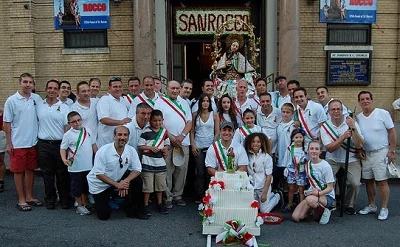

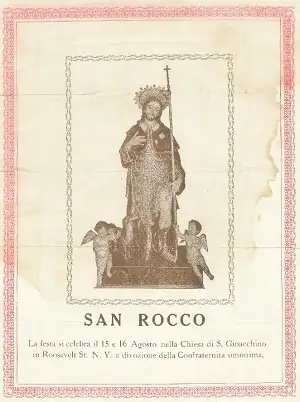
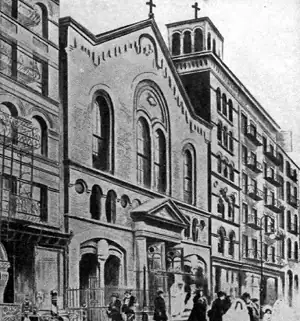
The St. Rocco Society was founded on Roosevelt Street in Manhattan's Lower East Side in 1889 by immigrants from the Southern Italian City of Potenza of the Basilicata region. They sought to form a society similar to the one they had at home in Italy. The mission of the society is to venerate the memory of St. Rocco and to promote and perpetuate the devotion to the blessed saint. The founding members commissioned a statue to be hand crafted in Italy similar to the statue they had back home across the Atlantic Ocean. The statue was housed in St. Joachim's Church where many of the members worshipped, in the neighborhood where they lived. One of the primary ways that the society achieves its mission is through the celebration of the annual Feast of St. Rocco. Every year since its founding, without interruption, the Society has celebrated Saint Rocco's Feast with a procession. It is one of the oldest Italian American societies in New York State.
After the demolition of Saint Joachim's Church due to urban renewal, the statue was moved to Saint Joseph's Church on Monroe and Catherine Streets (a few blocks from the original site) and the Feast was celebrated there. In 2015 St. Joseph's was closed due to consolidation within the Archdiocese. Upon the closing of St. Joseph's the statue and Feast was moved to Most Precious Blood Church at 113 Baxter Street, where it is held today.
Although the Society was founded by men from the Italian city of Potenza (some of whose descendants are still members of the society), from its earliest days immigrants from many towns in the provinces of Potenza and Matera participated in the procession. Eventually, those who participated came from every area of Southern Italy and Sicily.
The focus of the Feast is the procession of the Statue of Saint Rocco. Even before Saint Rocco begins "his walk" through the neighborhood, he is nearly covered with the money offerings of his faithful. The statue carried on the shoulders of the members is accompanied by an Italian street band for the entire length of the approximately three hour long walk. Following the statue, march the devotees as a means of thanking the saint for his powerful help and looking forward to future graces and blessings through his intercession.
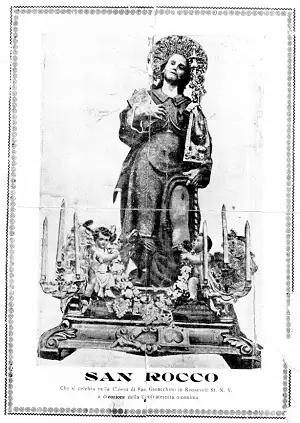
Well into the 1940's thousands of people traveled to St. Rocco's Feast to honor their beloved Saint by walking in his procession in the scorching August heat. However, with the passing of the years and a diminishing Italian population in the neighborhood, attendance, though remaining strong, lost some of its original strength. Through it all, Angela and Anna Carnevale, two dynamic sisters and daughters of one of the founding members of the society, kept the procession going without interruption. For too many years to count, their dedication kept the Feast alive. At Angela Carnevale's urging, Mr. Stephen La Rocca, an attorney and senior partner at the New York law firm of Stephen La Rocca, PLLC became President of the Society and assumed its leadership. Mr. La Rocca, made it his mission to renew the active participation of the Italian American community and all of the Saint Rocco devotees in this event. "It's like Christmas, Easter and my birthday all rolled up into one," says La Rocca.
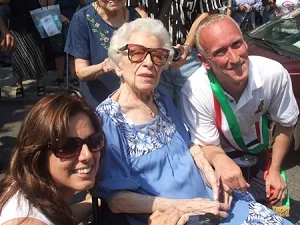
Sadly, Angela Carnevale passed away on Tuesday, September 22, 2009. The society is thankful for her lifelong commitment and today we still have a Saint Rocco Society and feast thanks to her. Mr. La Rocca said of her passing, "In Angela, I found a beloved friend, teacher, and confidant. There will never be another like her and my heart breaks at the loss of her presence in my life."
Literally to the end of her life she worked for St. Rocco and his Society. Her last concern in this world outside of her beloved family was for this Society and her Saint. We know that Saint Rocco has welcomed Angela into the joys of Heaven. La Rocca, the maternal grandson of immigrants from Basilicata (his paternal grandparents were from Sicily) has a fierce devotion to his patron saint and has restored the Feast to its former glory. "It started with a few friends willing to do me a favor," says La Rocca, "now we have 30-40 men in their 20s, 30s, and early 40s literally fighting over whose turn it is to carry the Saint and who would not miss the Feast for the world. The number of young men keeps growing each year.
After Saint Rocco's statue is let down from the men's shoulders to receive offerings and veneration as it is re-lifted onto their shoulders, the men shout with tremendous joy "VIVA SAN ROCCO!" - long live Saint Rocco. As the procession progresses, the shouting becomes contagious with participants in the procession as well as bystanders joining in with a heartfelt "VIVA SAN ROCCO!"
This Feast, although rejuvenated by these younger members remains an important event for the seniors who attend and cry tears of joy when they see the statue of Saint Rocco carried through the streets. So many who believed that the Feast was destined to get smaller are overjoyed that the Feast is stronger than ever with record numbers in attendance. With intensive advertising, some older Italian Americans have returned to lower Manhattan to celebrate a Feast they were not sure still existed. People come from all over the country as well as throughout the world each year for this event. Many people who return experience nostalgia, but more importantly exuberance over the Feast's extraordinary rebirth. Certainly the Feast is an event for all ages.